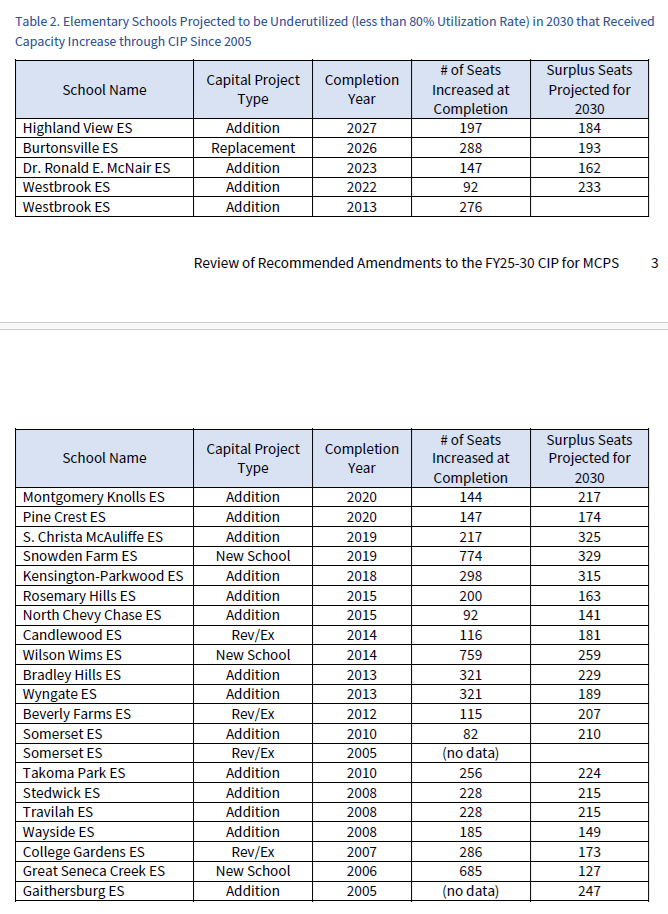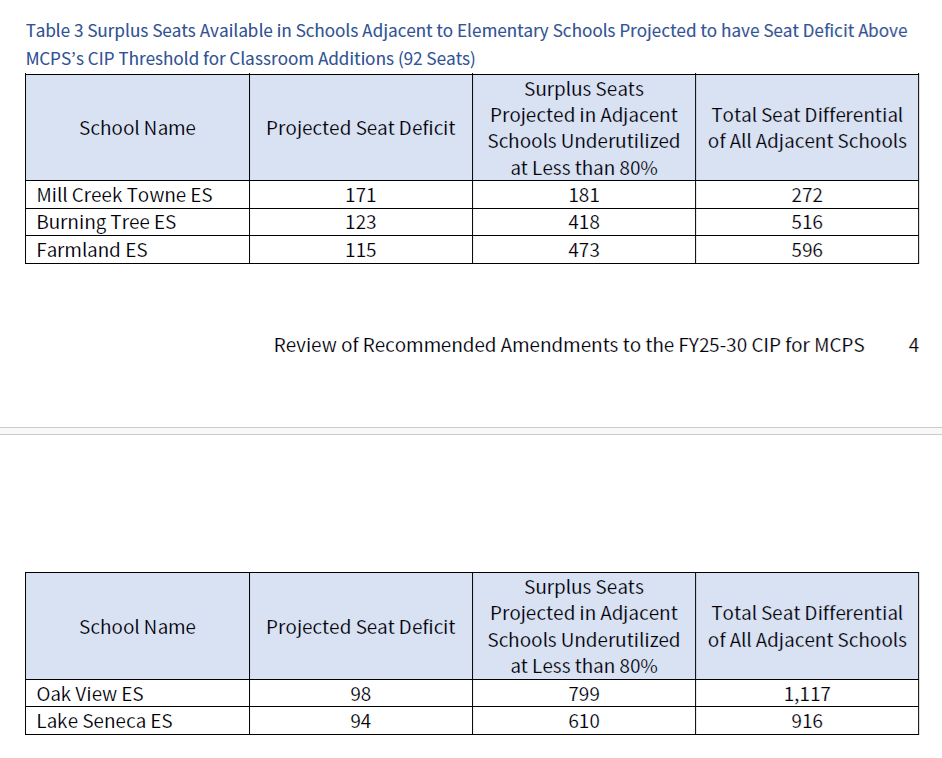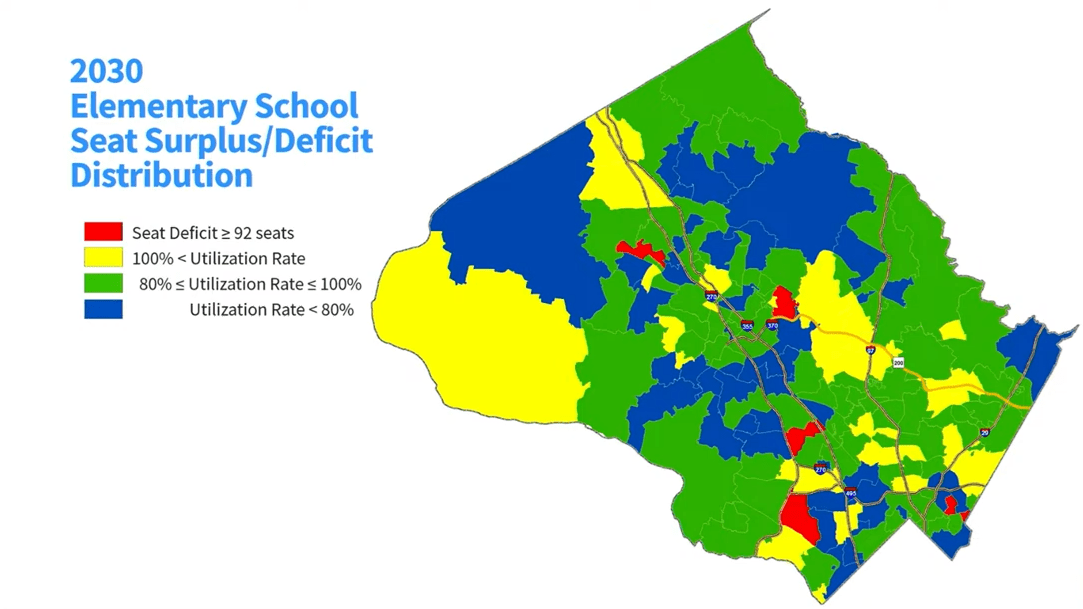By Adam Pagnucco.
With President Donald Trump about to rampage through MoCo’s critical federal sector and Governor Wes Moore proposing to drain more than $300 million a year from the county’s economy, county leaders had better start looking for future budget savings. Sure, they can always resort to their favored option of raising taxes, but the golden goose is sick. Where can they find some money?
Let’s start with MCPS’s capital budget.
MCPS’s capital improvement program (CIP) is one of the largest elements of the county’s capital budget. In the most recent county CIP, MCPS’s $1.85 billion in planned capital spending accounts for 31% of the county’s total. Like its operating budget, MCPS’s capital budget is originally formulated by the superintendent, modified and requested by the school board, sent to the county executive for a recommendation and ultimately decided by the county council. At this writing, the county executive has sent his recommended capital budget to the council and is blaming “sluggish development activity” for tight revenues. Hence the need to save money, not to mention the predations of the federal and state governments as noted above.
Let’s start with an element of context. The chart below shows MCPS’s total enrollment since 1969.

Historically, MCPS enrollment has varied in waves. The district saw a decline from 1973-1984, a rise from 1984-2006, a plateau in the mid-to-late 2000s and another rise through 2020. Since 2020, the district’s enrollment has declined by 3.4%. MCPS is no longer growing.
At a meeting of the Planning Board last week, planning staff discussed the county executive’s recommendation for MCPS’s capital budget. The staff’s memo is a must read for green eyeshades. Let’s start with this astounding statement by the staff:
If all projects within the FY25-30 CIP are completed at their approved scope and schedules, MCPS is projected to have a surplus of approximately 10,100 elementary school seats, 3,800 middle school seats, and 2,200 high school seats in the 2030-2031 school year.
Staff elaborated during discussion that the surpluses amount to 4% of high school seats, 10% of middle school seats and 13%(!) of elementary school seats.
Why is a school district that is not growing spending hundreds of millions of dollars to create surpluses of thousands of seats?
Let’s go further. MCPS has had an aggressive capital program in elementary schools, both new schools and additions, for 20 years. That may have made sense years ago when the system was growing. But that capital spending has resulted in more than 20 elementary schools that will have utilization rates of less than 80% by 2030. The planning staff assembled the list below of elementary schools with either new buildings or additions in the last 20 years that will have significant seat surpluses. In other words, we built lots of capacity for students who never ultimately enrolled.

That said, there are also 25 elementary schools operating at utilization rates of more than 100%. Not all of them will be getting additions or new buildings. The planning staff wrote, “According to MCPS’s capital planning guidelines however, for a classroom addition at an individual school to be considered for funding in the CIP, the enrollment needs to exceed its program capacity by a minimum of 92 seats or more in the sixth year of the CIP period for an elementary school.”
How many elementary schools are over capacity by 92 seats or more? The answer is five: Mill Creek Towne ES in Rockville, Burning Tree ES in Bethesda, Farmland ES in Rockville, Oak View ES in Silver Spring and Lake Seneca ES in Germantown. Planning staff comments, “…All five of those schools are adjacent to underutilized schools operating at less than 80%, and the total surplus seats projected to be available at the adjacent underutilized schools exceed the seat deficits projected at the overutilized schools.”
Translation: these schools don’t need additions. Their capacity issues can be fixed by adjusting boundary lines with adjacent elementary schools that have surplus capacity.
Here is the list along with the surpluses in adjacent elementary schools.

During the discussion, planning staff produced the map below showing how crowded elementary schools are right next to underutilized schools as of 2030. The red areas are crowded elementary school service areas that are at least 92 seats over capacity. The blue areas are elementary school service areas which have utilization rates of less than 80%. See how the red (crowded) schools are right next to blue (underutilized) schools?

We’re not talking about “busing kids across the county,” which is the typical line used by boundary study opponents. We’re talking about saving millions of dollars by adjusting lines between adjacent elementary schools. This policy could conceivably be considered under MCPS’s massive boundary review for high schools and middle schools that is now underway, but that study does not include elementary schools.
How much money could be saved by relying on adjacent boundary adjustments rather than capital projects? We can get an idea by examining MCPS’s current capital budget request, which includes funding for two new elementary schools and three elementary school additions. The two new schools cost $67 million and $58 million. The additions cost $17 million, $18 million and $20 million. These projects are underway now and probably can’t be canceled, but could any of their costs have been reduced or eliminated by boundary adjustments before they were placed in the capital budget?
The real savings lie in the future. The superintendent’s recommended FY26 capital budget is full of planning studies for major capital projects. Not all of them will result in actual projects. But some of them might. Could any of those be remediated through boundary tweaks?
I know what I’m going to hear from MCPS after I publish this. “We always consider alternatives to capital projects when evaluating utilization.” Go ahead and email me, folks – you know how to reach me! But the record assembled by the planning staff shows that MCPS has not done a great job at this due to its large and growing seat surpluses. They need to double down on using solutions to their capacity issues that do not exclusively rely on tens of millions of dollars in taxpayer money. That is especially true considering that the school board is seeking a $333 million increase to its operating budget, which would probably call for a large property tax increase if fully funded.
So bring on the green eyeshades. Lord knows we need them!
